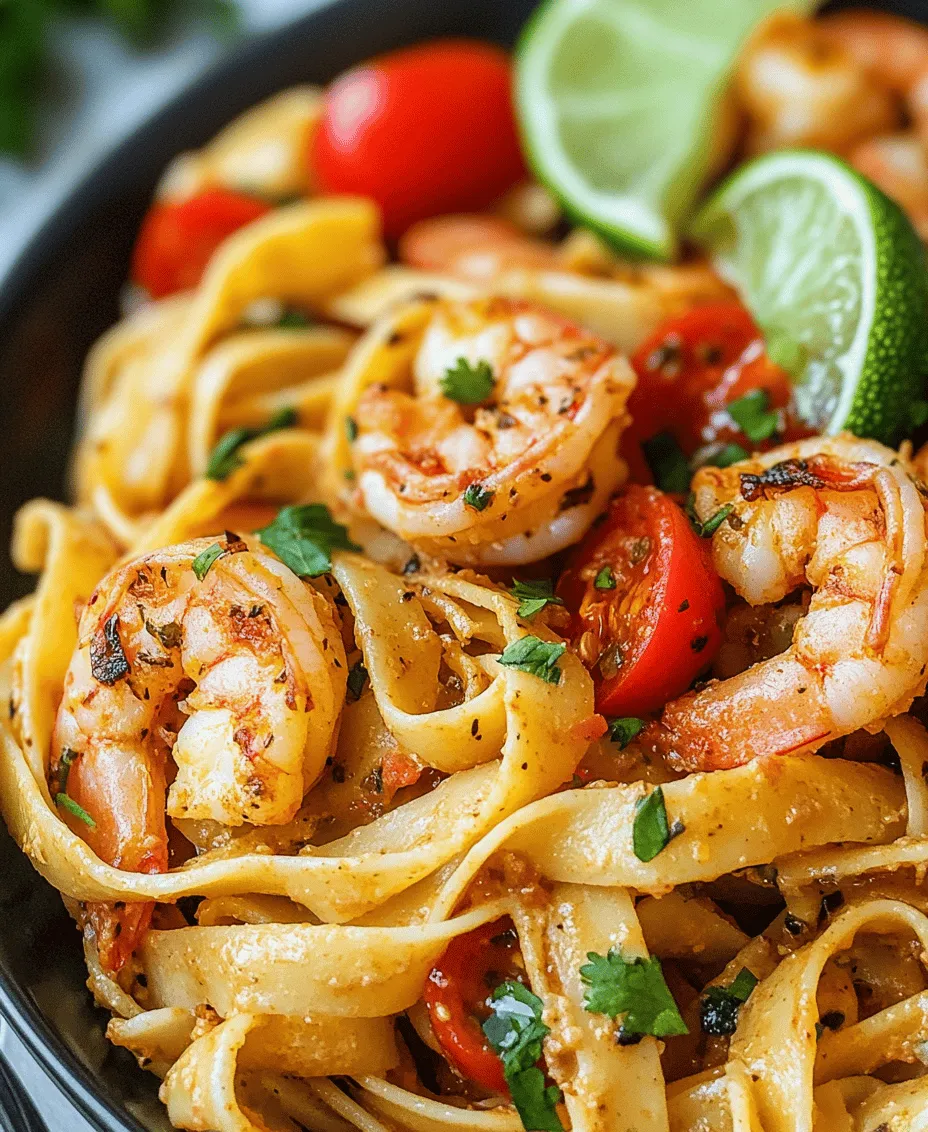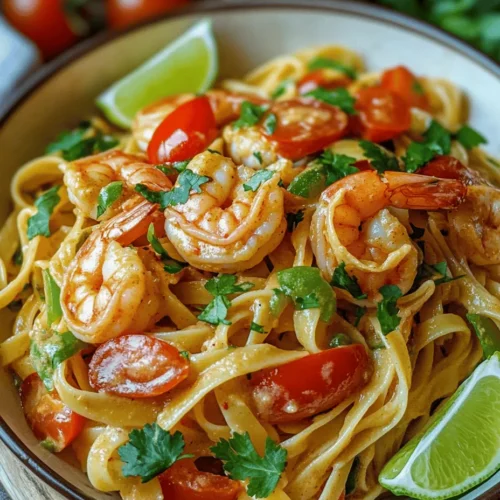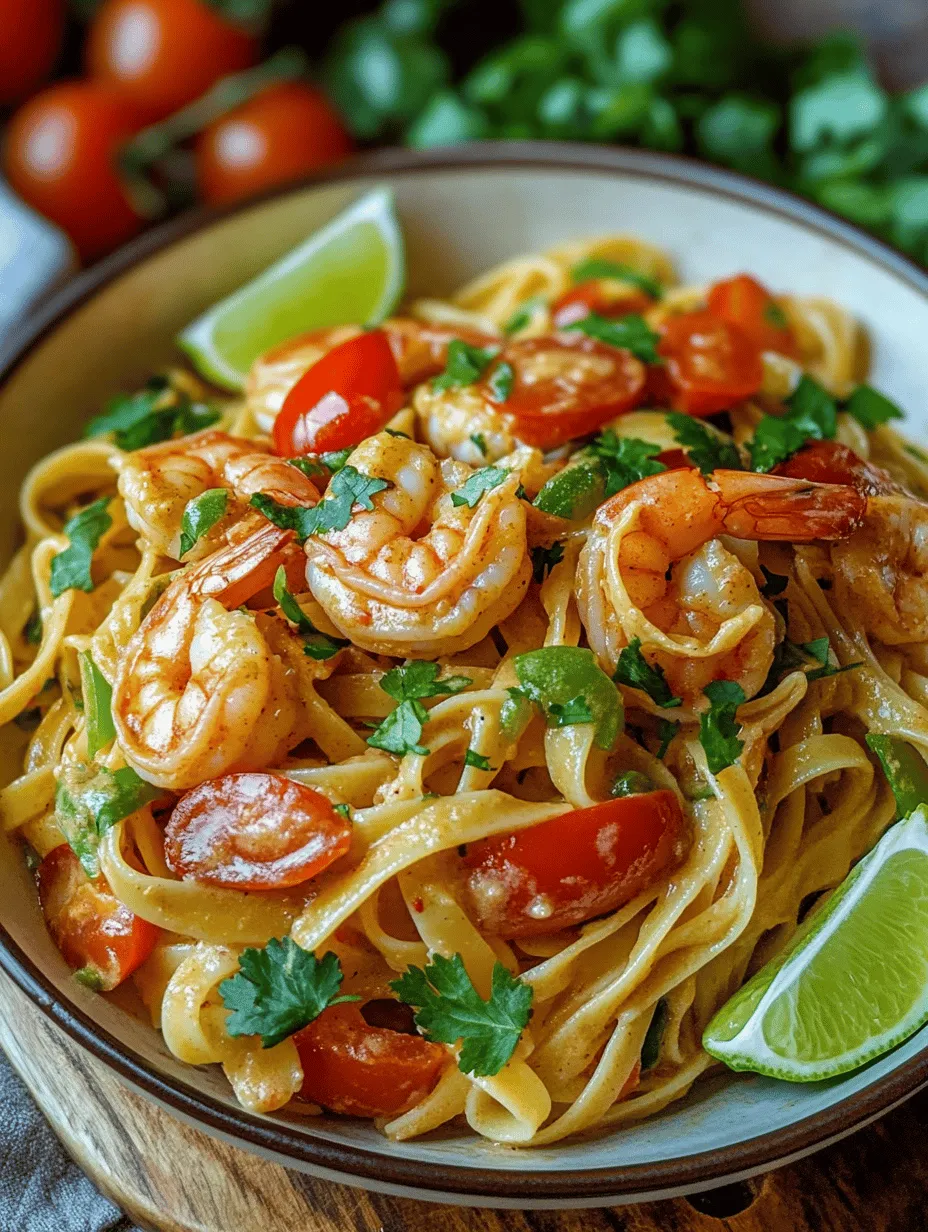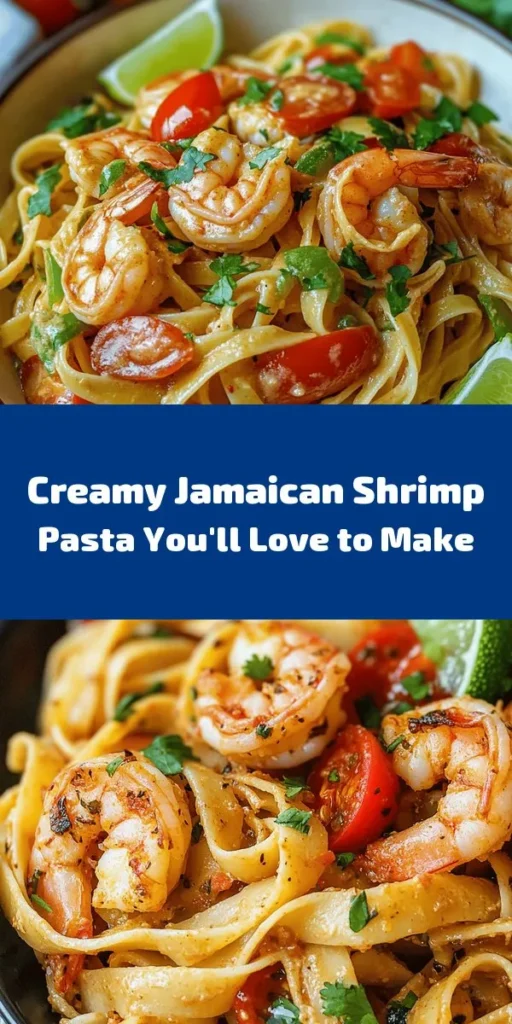Introduction
Jamaican cuisine is a vibrant tapestry of flavors, colors, and aromas that reflect its rich cultural heritage. With influences from Africa, Europe, and the indigenous Taino people, Jamaican dishes are renowned for their bold spices and fresh ingredients. Among the many delightful offerings of this culinary tradition, seafood holds a special place, embodying the island’s connection to the sea. One dish that beautifully marries these elements is Jamaican Shrimp Pasta—a fusion of Caribbean flavors and traditional Italian comfort food that promises to tantalize your taste buds.
This delectable pasta dish is not only an ode to the rich, spicy palate of Jamaica but also a creamy indulgence that is both comforting and satisfying. The combination of succulent shrimp, a velvety sauce, and perfectly cooked pasta creates a meal that is as inviting as it is delicious. Whether you’re hosting a casual dinner or planning a special occasion, Jamaican Shrimp Pasta is a versatile dish that is sure to impress your guests and elevate your dining experience.
What makes this recipe particularly appealing is its simplicity. While it boasts complex flavors that celebrate the essence of Jamaican cooking, the dish can be prepared in a relatively short amount of time, making it accessible for cooks of all skill levels. As you dive into this culinary journey, you’ll find that the heart of Jamaican Shrimp Pasta lies in its harmonious blend of ingredients, each contributing to the overall flavor profile and texture.
The Inspiration Behind Jamaican Shrimp Pasta
To truly appreciate Jamaican Shrimp Pasta, one must explore the cultural significance of shrimp in Jamaican cooking. Shrimp is a staple in many Caribbean kitchens, prized not only for its delectable taste but also for its nutritional benefits. Rich in protein and low in calories, shrimp is a popular choice that fits well into various diets, making it a favored ingredient among health-conscious individuals.
The incorporation of shrimp into this pasta dish is a nod to Jamaica’s coastal geography, where fresh seafood is abundant. In Jamaican culture, shrimp is often cooked with spices and herbs that enhance its natural sweetness, and this recipe is no exception.
A defining characteristic of Jamaican cuisine is the use of jerk seasoning—a fiery blend of spices that includes allspice, thyme, and Scotch bonnet peppers. The inclusion of jerk seasoning in Jamaican Shrimp Pasta infuses the dish with its signature heat and depth, creating a tantalizing flavor that resonates with those familiar with the cuisine. Allspice, in particular, is crucial to this dish; its warm, aromatic notes complement the sweetness of the shrimp and the creaminess of the sauce, resulting in a well-rounded and satisfying meal.
This recipe celebrates the rich culinary heritage of Jamaica while appealing to a global palate. By merging traditional Jamaican flavors with the comforting nature of Italian pasta, Jamaican Shrimp Pasta offers a unique dining experience that showcases the best of both worlds. It allows you to savor the essence of the Caribbean while indulging in the beloved tradition of pasta, making it a dish that transcends cultural boundaries.
Ingredients Breakdown
When preparing Jamaican Shrimp Pasta, the quality and selection of ingredients play a pivotal role in achieving the right flavor and texture. Below is a detailed breakdown of each ingredient that contributes to the dish’s deliciousness:
Fettuccine or Linguine: The Importance of Pasta Choice
The choice of pasta is fundamental to the overall experience of the dish. Fettuccine and linguine are both excellent options for Jamaican Shrimp Pasta. Fettuccine, with its broad, flat ribbons, holds onto the creamy sauce beautifully, while linguine, being slightly thinner, provides a delicate mouthfeel. Regardless of your choice, opt for high-quality, fresh pasta whenever possible for the best results. Cooking the pasta to an al dente texture is essential, as it allows for a perfect bite that complements the creamy sauce.
Shrimp: Nutrition and How to Select the Best Quality
When it comes to shrimp, freshness is key. Look for shrimp that is firm with a slightly translucent appearance. The best shrimp are often wild-caught, as they tend to have a superior flavor compared to farmed varieties. If you are purchasing frozen shrimp, ensure that they are packaged well and devoid of any freezer burn. For this recipe, medium to large shrimp work best, as they provide a satisfying bite and can stand up to the robust flavors of the dish.
Olive Oil and Butter: The Role of Fats in Creating Flavor
A combination of olive oil and butter is used to sauté the shrimp and aromatics, resulting in a rich and flavorful base for the dish. Olive oil lends a fruity note, while butter adds a luxurious creaminess that enhances the overall texture of the sauce. This combination not only helps to cook the shrimp evenly but also contributes to the depth of flavor that defines Jamaican Shrimp Pasta.
Aromatics: Importance of Onion and Garlic in Building Flavor
Onion and garlic are essential aromatics that form the backbone of many dishes, and they are no exception in this recipe. Sautéing these ingredients releases their natural sweetness and adds layers of flavor to the sauce. The aromatic qualities of onion and garlic will mingle beautifully with the shrimp, creating a savory foundation that elevates the entire dish.
Bell Peppers: Color, Crunch, and Nutrition
Adding bell peppers to Jamaican Shrimp Pasta introduces a pop of color, a satisfying crunch, and additional nutrition. The sweetness of bell peppers complements the other ingredients and balances the heat from the jerk seasoning. Choose a mix of colors—red, yellow, and green—for visual appeal and to maximize flavor diversity.
Spices: The Significance of Allspice and Jerk Seasoning in Jamaican Cuisine
Allspice is a key ingredient in Jamaican cooking, providing a warm, aromatic flavor that is unlike any other spice. It is essential for bringing out the unique profile of this dish. Jerk seasoning, a hallmark of Jamaican cuisine, offers a spicy kick that enhances the shrimp and adds character to the sauce. When combined, these spices create a deliciously complex flavor that is both comforting and invigorating.
Coconut Milk and Heavy Cream: The Essence of Creaminess and Tropical Flavor
The creamy aspect of Jamaican Shrimp Pasta comes from a blend of coconut milk and heavy cream. Coconut milk infuses the dish with a tropical richness that complements the shrimp beautifully, while heavy cream adds an extra layer of indulgence. This combination results in a velvety sauce that clings to the pasta, making each bite a delightful experience.
Broth: Options for Enhancing the Sauce’s Depth
To elevate the sauce further, consider using seafood broth or chicken broth. This addition enhances the overall flavor profile and adds depth to the creamy sauce. If you want to keep the dish light, a vegetable broth can be used as a substitute, ensuring that the dish remains flavorful without overpowering the shrimp.
Cherry Tomatoes: Adding Freshness and Acidity
Cherry tomatoes bring a burst of freshness and acidity to the dish, cutting through the richness of the sauce. Their natural sweetness complements the spices and enhances the overall flavor balance. Halve the tomatoes and add them towards the end of cooking to maintain their shape and juiciness.
Fresh Herbs and Lime: Final Touches for Brightness and Garnish
Fresh herbs, such as cilantro or parsley, are the perfect finishing touch for Jamaican Shrimp Pasta. They not only add a vibrant green color but also a burst of freshness that brightens the dish. A squeeze of lime juice just before serving adds a zesty kick that elevates the overall flavor profile, making each bite even more delicious.
Step-by-Step Cooking Instructions
Cooking the Pasta
1. Boil Water: Start by bringing a large pot of salted water to a rolling boil. The salt enhances the pasta’s flavor, so don’t skip this step.
2. Add Pasta: Once the water is boiling, add your choice of fettuccine or linguine. Stir gently to prevent the pasta from sticking together.
3. Cook to Al Dente: Follow the package instructions for cooking time, but test the pasta a minute or two before the time is up. You want it to be al dente—firm to the bite yet cooked through. This texture allows the pasta to absorb the creamy sauce better.
4. Reserve Pasta Water: Before draining the pasta, reserve about a cup of the pasta water. This starchy water is a valuable ingredient that can be used to adjust the consistency of your sauce later on.
5. Drain and Set Aside: Drain the cooked pasta and set it aside. It’s important to do this quickly to prevent it from overcooking.
Sautéing the Shrimp
1. Heat the Oil and Butter: In a large skillet, heat a tablespoon of olive oil and a tablespoon of butter over medium heat. Allow the butter to melt and bubble slightly.
2. Add Aromatics: Once the oil and butter are hot, add diced onion and minced garlic to the pan. Sauté for about 2-3 minutes, or until the onion becomes translucent and fragrant.
3. Incorporate Bell Peppers: Add the sliced bell peppers to the skillet and cook for another 2-3 minutes, allowing them to soften slightly while maintaining their crunch.
4. Season the Shrimp: Pat the shrimp dry with a paper towel and season them with jerk seasoning and allspice. This step ensures that the shrimp are well-coated with flavor.
5. Cook the Shrimp: Increase the heat to medium-high and add the seasoned shrimp to the skillet. Cook for 2-3 minutes on each side until they turn pink and opaque. Be careful not to overcook the shrimp, as they can become tough.
As you progress through these initial steps, you’ll see how the elements of Jamaican Shrimp Pasta come together. The aroma of the sautéed vegetables and spices will fill your kitchen, enticing your senses and setting the stage for a delicious meal. In the next part, we’ll delve into combining the sauce with the pasta and finishing touches that make this dish a true delight. Stay tuned for the continuation of this creamy culinary journey!

Balancing Seasoning and Spice Levels
When preparing Jamaican Shrimp Pasta, achieving the right balance of seasoning and spice is crucial for a dish that truly represents the vibrant flavors of Jamaica. Start by seasoning the shrimp with a blend of salt, black pepper, and a pinch of cayenne for a subtle kick. Remember, you can always add more spice later, but it’s challenging to tone it down once it’s in.
To enhance the dish’s depth, consider adding herbs like thyme or a dash of allspice. These spices are hallmarks of Jamaican cuisine and will elevate the overall flavor profile of your dish. As you cook, keep tasting the sauce and adjusting the seasoning as needed, especially after adding ingredients that might dilute the flavor, such as the coconut milk.
Cooking the Vegetables
Cooking the vegetables is an essential step in building the flavor base for your Jamaican Shrimp Pasta. Start by heating olive oil in a large skillet over medium heat. Add chopped onions and minced garlic, allowing them to turn translucent and fragrant—about 2-3 minutes. Next, add bell peppers, sliced thinly for even cooking.
Timing and Order for Adding Ingredients to Maximize Flavor
The order in which you add ingredients can significantly affect the final flavor of your dish. After the onions and garlic have softened, incorporate the bell peppers first, cooking them until slightly tender but still crisp, about 4-5 minutes. This timing ensures they retain their vibrant color and crunch, contributing texture to the pasta.
Once the bell peppers are ready, add other vegetables like zucchini or spinach. These should be added later in the cooking process as they require less time to cook. This method maximizes their flavor and nutrients while ensuring they don’t become mushy.
How to Achieve the Right Texture for Bell Peppers
To achieve the perfect texture for bell peppers, slice them into uniform pieces. This allows for even cooking and prevents some pieces from becoming overcooked while others remain crunchy. When sautéing, keep the heat at medium to medium-high; this allows the peppers to caramelize slightly without burning, enhancing their natural sweetness.
Making the Sauce
The sauce is where the magic happens in Jamaican Shrimp Pasta. Begin by pouring in the coconut milk after the vegetables have softened. Use full-fat coconut milk for a richer flavor and creamier texture. Stir in your favorite herbs and spices—like thyme, paprika, and a hint of lime juice—to create the perfect balance of flavors.
Techniques for Achieving the Perfect Creamy Consistency
To achieve a creamy consistency, allow the coconut milk to simmer gently. This will help it thicken slightly, creating a luxurious sauce that clings to the pasta. If you prefer an even thicker sauce, you can add a spoonful of cornstarch mixed with water, stirring it in gradually until you reach your desired thickness.
Adjusting Flavors and Seasoning During Cooking
As the sauce simmers, take the time to adjust flavors. Add more lime juice for acidity or a pinch of sugar if the sauce feels too acidic. Taste as you go—this is crucial for developing the best flavor. You can also add a splash of soy sauce for umami or even a bit of hot sauce if you enjoy extra heat.
Combining Ingredients
Once your sauce has reached the desired consistency, it’s time to combine everything. Add the cooked pasta directly into the skillet with the sauce and vegetables. Use tongs to toss everything together, ensuring that each strand of pasta is coated in the creamy sauce. If the sauce is too thick, add a splash of pasta water to loosen it up.
Best Practices for Mixing Pasta with the Sauce and Other Components
When mixing the pasta with the sauce, do so off the heat to prevent the pasta from overcooking. It’s important to ensure that the pasta is al dente before adding it to the sauce, as it will continue to cook slightly once combined. This method helps maintain a pleasant texture throughout the dish.
Importance of the Right Sauce Consistency for Coating Pasta
The right sauce consistency is paramount for a successful Jamaican Shrimp Pasta. A sauce that is too runny will not cling well to the pasta, resulting in a bland dish. Conversely, a sauce that is too thick can overpower the other flavors. Aim for a consistency that is creamy and coats the pasta well, allowing each bite to be flavorful.
Serving Suggestions
Presentation plays a key role in enjoying your Jamaican Shrimp Pasta. When serving, consider garnishing with freshly chopped cilantro or parsley for a pop of color. A sprinkle of lime zest can also brighten the dish, enhancing its tropical flavors.
For a complete meal, serve your pasta with a side of garlic bread or a fresh garden salad topped with a light vinaigrette. These sides complement the richness of the pasta while adding freshness to your plate.
Creative Garnishing Ideas and the Role of Lime for Enhancing Flavor
Garnishing is an opportunity to add visual appeal and flavor. Consider topping your dish with sliced red chili for heat, or toasted coconut flakes for added texture. Lime wedges on the side allow each diner to add a fresh squeeze, brightening the dish and enhancing the tropical elements of the flavor profile.
Pairing Suggestions for Sides or Beverages
Pair your Jamaican Shrimp Pasta with a chilled white wine, such as Sauvignon Blanc or a light lager beer, to enhance the dish’s flavors. If you’re looking for a non-alcoholic option, a refreshing ginger beer or a coconut-infused iced tea would complement the dish beautifully.
Nutritional Information
Jamaican Shrimp Pasta not only satisfies your taste buds but also offers numerous nutritional benefits.
– Protein Content from Shrimp: Shrimp is an excellent source of protein, providing essential amino acids that help with muscle repair and growth. A standard serving of shrimp contains about 24 grams of protein, making this dish a hearty option for those seeking a protein-rich meal.
– Healthy Fats from Olive Oil and Coconut Milk: The use of olive oil provides healthy monounsaturated fats, while coconut milk contributes medium-chain triglycerides (MCTs), which are beneficial for metabolism and energy.
– Fiber and Vitamins from Vegetables: The addition of bell peppers, zucchini, and spinach not only adds flavor but also provides dietary fiber, vitamins A and C, and antioxidants that contribute to overall health.
– Caloric Breakdown per Serving and Health Considerations: On average, a serving of Jamaican Shrimp Pasta contains around 500-600 calories, depending on portion size and additional ingredients. It’s a well-rounded meal that offers a balance of macronutrients while being mindful of calorie intake.
Variations and Customizations
One of the best aspects of Jamaican Shrimp Pasta is its versatility. Here are some suggestions for variations and customizations:
– Suggestions for Making the Dish Vegetarian or Vegan: To create a vegetarian version, simply omit the shrimp and replace it with sautéed mushrooms or eggplant for a hearty texture. For a vegan alternative, consider using plant-based shrimp made from soy or pea protein.
– Alternative Proteins: If you’re looking for alternative proteins, tofu is a great option. Marinate it in the same spices used for the shrimp to maintain flavor.
– Dairy-Free Options for the Sauce: To make the sauce dairy-free, stick with coconut milk, or use a cashew cream made by blending soaked cashews with water for a similar creamy texture.
– Adjusting Spice Levels for Different Palates: Tailor the spice levels to your preference by adjusting the amount of cayenne or omitting the hot sauce. You can also serve it on the side for those who enjoy heat.
– Seasonal Variations with Different Vegetables: Feel free to swap in seasonal vegetables such as asparagus in the spring or roasted butternut squash in the fall. This flexibility allows for a fresh twist on the classic dish.
Conclusion
Jamaican Shrimp Pasta is a delightful fusion of flavors that brings the warmth of the Caribbean to your dining table. Its creamy texture, vibrant colors, and rich seasoning make it a comforting yet exotic meal that is sure to impress family and friends.
Trying your hand at this recipe not only allows you to explore new culinary techniques but also invites you to share the joy of cooking with loved ones. The unique blend of cultures and flavors in this dish serves as a reminder of the wonderful experiences that come from preparing and enjoying food together. So gather your ingredients, embrace the cooking process, and savor every bite of your homemade Jamaican Shrimp Pasta.



